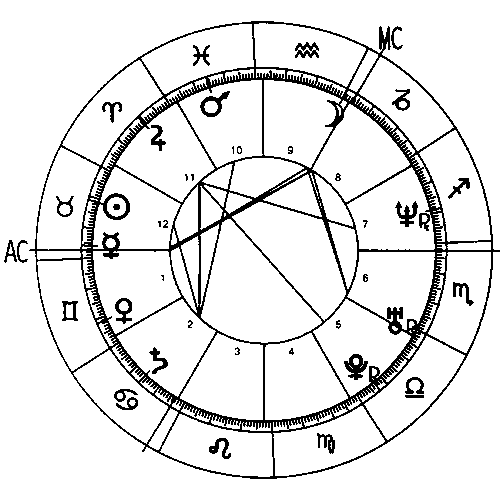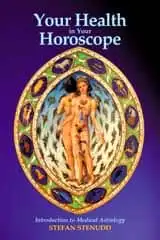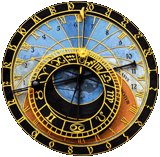|
by Stefan Stenudd
|
Your own horoscopeThe Complete Chart of Classical Astrology The age old system of astrology has found a great assistant in the modern computer. With it, calculating a complete horoscope chart works like a charm.
If you're interested in charting more horoscopes than your own, you may want to purchase an astrology program to install on your computer. You see a few alternatives of such programs further down on this webpage. One of them is free of charge, but the others usually cost more than $ 100, in some cases twice or three times that sum. But if you just want to find out the details of your own birth chart, it can be done for free on a number of websites. They are listed right below this text.
What you need to knowThis is what you need to know, in order to get your precise birth chart:
The time of your birth should be as exact as possible — to the minute. That can be tricky. Some hospitals record the birth time as a routine, others not. Mothers should not be trusted to remember with any accuracy — they were quite preoccupied at the time. Be suspicious of a birth time on the hour, like 6AM or 4PM, also something like 6:30AM or 4:15PM. If you come across an odd time, like 6:28AM or 4:14PM you can probably trust it to the minute. A birth time given as 6:25AM is probably something between 6:23 and 6:27, which is close enough. For most things in the horoscope, a few minutes make almost no difference at all. Watch out with the ascendant, Medium Coeli and the House cusps, though. They have a mean movement of 1° in 4 minutes — sometimes faster, sometimes slower. The moon has a mean movement of 13°/day, so it takes a lot of minutes for the moon to move significantly. The other components of the horoscope are much slower. If you don't know your birth time at all, make a horoscope chart for 12:00PM — midday. That way, the horoscope can not be more than 12 hours wrong. Of course, that's far too much when it comes to the Ascendant (AC), Medium Coeli (MC) and the House cusps — so you have to do without those in your chart, until you found out your birth time. There are astrological methods for figuring out a birth time. You simply check transits and progressions — methods of prediction through planet movements in relation to the birth chart — and compare with significant events in your life. Thus, you sort of go the reverse way to establish your birth time. I am not too fond of that method, since it demands trust in astrology before it can prove itself — also, there is much room for misunderstanding, since transits and progressions sometimes work in mysterious ways. You do better to use some detective work to find out your actual birth time. The place of your birth is probably as well known to you as the date is. You don't need to be more precise than the city — or the nearest town, if you were born in the countryside. Don't go calculate the exact position of the hospital where you were delivered. Ten kilometers make almost no difference in the chart, nor do 20 or 30. Observe that longitude (east-west distance measured from Greenwich in England) makes slightly more difference than latitude (north-south of the Equator). Still, don't worry about anything less than 30 kilometers. Most computer programs have lists of thousands of cities and their longitude and latitude, so you rarely need to check that yourself. There is one oddity with latitude — in the polar regions, beyond the arctic circles (latitude 66°23.5' North and South), astronomical formulas can't really calculate the Ascendant. It is done with approximation, and some other tricks. Astrological computer programs do it without hesitation — their manuals should reveal why and how. Anyway, if you're born in a polar region, you should consider this (see Ivan Wilhelm's learned text about it).
Chart typesThe internet resources and computer programs listed below have slightly differing designs, but their calculation results should be identical. Much bigger differences are to be found in the many kinds of horoscope charts there are to choose between — in any horoscope chart program. There are many options, some of them quite cryptical and confusing to anyone but the most knowledgeable astrologer.If you're not sure about what choices to make, do like with any computer program — stick with the default options. Except for pure differences in design, these are the most important alternatives for horoscope charts:
I have the impression that Placidus is the most commonly used House system. Me, I prefer Equal House, for a number of reasons. It relates logically to the Zodiac, where each sign is also 30°, it adds nuance to the MC, it is mathematically more sound — and it's the oldest, used already by Ptolemy. What you should do, though, is to compare the two systems on your horoscope, and decide for yourself which one fits you the best.
Planet symbols (glyphs). From left to right: sun, moon, Mercury, Venus, Mars, Jupiter, Saturn, Uranus, Neptune, Pluto, Ascendant, Medium Coeli, moon node.
In addition to those, the lunar nodes — Dragon's Head and Dragon's Tail — are quite often used. Some use Chiron, a celestial body discovered in 1977, and some add asteroids, fixed stars, mathematically calculated points, and so on. Which ones to use? The ones you are familiar with and have found valuable to include. Again, use your own horoscope as a guinea pig to reach your own conclusions. I recommend that you start with only the twelve of the list above. They are a handful to interpret, so you are in no hurry to complicate your horoscope additionally, before being well acquainted with them. Aspects and their orbs have their default values in any horoscope computer program, but most of them allow for the user to adjust these values. There are five basic aspects, used already by Ptolemy:
Aspect symbols (glyphs): conjunction, opposition, trine, square, sextile.
The orb is the number of degrees allowed for an angle to be marked as an aspect in the horoscope. For example, a 10° orb makes anything between 110° and 130° a trine. Of course, the bigger the orb, the more aspects in a horoscope. It is common for astrologers to use different orbs for different aspects — a big one to the strongest aspects, the conjunction and opposition, and a small one to the weakest, the sextile. In any case: an aspect is more important if it is closer to exact. I use rather small orbs — 4° for all aspects. I do so, because you tend to look at relations between planets anyway — whether they are actually in aspect or not — so you need to have the close ones pointed out clearly. No need to make a cobweb of the chart.
Zodiac sign symbols (glyphs). From left to right: Aries, Taurus, Gemini, Cancer, Leo, Virgo, Libra, Scorpio, Sagittarius, Capricorn, Aquarius, Pisces.
The above are the central components of astrology and the horoscope. Read more about them on this website, by exploring the menu on the left. I hope that my texts will help you interpret and understand your own horoscope. You will surely enjoy the process.
Free horoscope calculationsAstrolabe Chart
AstroDienst Charts
0800-Horoscope Chart
AstroMart Chart calculation
Martin Bulgerin Transit calculator
Horoscope computer programsAstrolog — FREE!
Kairon — for Mac
Matrix Win Star
AstroLabe Solar Fire
MenuCOMPLETE HOROSCOPEHow to Make Your Own HoroscopeYour Health HoroscopeSex in Your HoroscopeZodiac ArchetypesFinancial AstrologyDaily Horoscope Guide — What to ExpectTetrabiblos — the Ancient Astrology BibleHOROSCOPE BASICSZodiac — the "how" of the horoscopePlanets — the "what" of the horoscopeHouses — the "where" of the horoscopeAspects — the "why" of the horoscopeFAMOUS HOROSCOPESDonald Trump — 2025 inauguration horoscope2024 presidential election horoscope for Kamala Harris2024 presidential election horoscopes for Donald Trump and Joe BidenJoe Biden's 2020 presidential election horoscopePete Buttigieg's 2020 presidential election horoscopeDonald Trump — impeachment horoscopeDonald Trump — will he resign?Hillary ClintonMike PenceBarack ObamaAnders Behring BreivikMichael JacksonSarah PalinBrad PittThe USA Horoscope — Finding and Reading ItPREDICTIONSThe USA Pluto return 2022 horoscopeCapitol attack horoscopeCovid-19 coronavirus horoscopeFuture of the InternetThe Age of AquariusUSA 2016 ElectionMundane Pluto — Its Effect on SocietyMundane Neptune — Its Effect on the ArtsMISCAbout the Complete Horoscope WebsiteDisappearing Ascendant — Latitude EffectsThe Envelope Chart — Horoscope of the PastAstrology LinksAstrologi på svenskaContactCookiesZODIAC SIGNSThe twelve Zodiac signs and what they mean in astrology.
MY OTHER WEBSITES
Tarot Card Meanings
I Ching Online
Stefan Stenudd
About meI'm a Swedish astrologer, author and historian of ideas, researching ancient thought and mythology. My personal website: stenudd.com
|


 If you're unsure of your Zodiac sign, or if you want to know on what degree (between 0° and 30°) of the sign the sun was at your birth, please visit the Zodiac sign calculator. It's very easy to use, and then you'll know for sure. (I designed this calculator, but it's moved to another website.)
If you're unsure of your Zodiac sign, or if you want to know on what degree (between 0° and 30°) of the sign the sun was at your birth, please visit the Zodiac sign calculator. It's very easy to use, and then you'll know for sure. (I designed this calculator, but it's moved to another website.)


